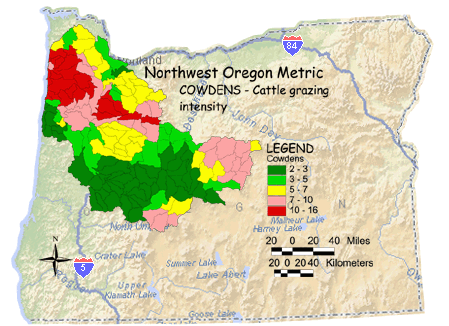 Northwest
Oregon Metric Maps Northwest
Oregon Metric Maps
 HUCs
- 10 digit HUCs
- 10 digit
 U_INDEX
Human Land Use U_INDEX
Human Land Use
 RHUM0
Stream Corridor RHUM0
Stream Corridor
 RHUM30
30 Meter RHUM30
30 Meter
 RHUM90
90 Meter RHUM90
90 Meter
 N_INDEX
Natural Land Use N_INDEX
Natural Land Use
 RNAT0
Stream Corridor RNAT0
Stream Corridor
 RNAT30
30 Meter RNAT30
30 Meter
 RNAT90
90 Meter RNAT90
90 Meter
 PBAR
Barren PBAR
Barren
 RBAR0
Stream Corridor RBAR0
Stream Corridor
 RBAR30
30 Meter RBAR30
30 Meter
 RBAR90
90 Meter RBAR90
90 Meter
 PAGT
Agriculture PAGT
Agriculture
 RAGT0
Stream Corridor RAGT0
Stream Corridor
 RAGT30
30 Meter RAGT30
30 Meter
 RAGT90
90 Meter RAGT90
90 Meter
 PAGC
Cropland PAGC
Cropland
 RAGC0
Stream Corridor RAGC0
Stream Corridor
 RAGC30
30 Meter RAGC30
30 Meter
 RAGC90
90 Meter RAGC90
90 Meter
 PAGP
Pasture PAGP
Pasture
 RAGP0
Stream Corridor RAGP0
Stream Corridor
 RAGP30
30 Meter RAGP30
30 Meter
 RAGP90
90 Meter RAGP90
90 Meter
 PURB
Urban PURB
Urban
 RURB0
Stream Corridor RURB0
Stream Corridor
 RURB30
30 Meter RURB30
30 Meter
 RURB90
90 Meter RURB90
90 Meter
 PWETL
Wetland PWETL
Wetland
 RWETL0
Stream Corridor RWETL0
Stream Corridor
 RWETL30
30 Meter RWETL30
30 Meter
 RWETL90
90 Meter RWETL90
90 Meter
 PFOR
Forest PFOR
Forest
 RFOR0
Stream Corridor RFOR0
Stream Corridor
 RFOR30
30 Meter RFOR30
30 Meter
 RFOR90
90 Meter RFOR90
90 Meter
 AGTSL5
- Steep Slopes AGTSL5
- Steep Slopes
 STRMLEN
Stream Length STRMLEN
Stream Length
 STRMDENS
Stream Density STRMDENS
Stream Density
 RDLEN
Road Length RDLEN
Road Length
 RDLENCINTE
Interstates RDLENCINTE
Interstates
 RDLENCHIGH
Highways RDLENCHIGH
Highways
 RDLENCROAD
Surface Road RDLENCROAD
Surface Road
 RDDENS
Road Density RDDENS
Road Density
 RDDENSCINT
Interstates RDDENSCINT
Interstates
 RDDENSCHIG
Highways RDDENSCHIG
Highways
 RDDENSCROA
Surface Road RDDENSCROA
Surface Road
 FNUMBER
Forest Patches FNUMBER
Forest Patches
 FPATDENS
Forest Density FPATDENS
Forest Density
 FLARGEST
Largest Forest FLARGEST
Largest Forest
 FAVGSIZE
Average Forest FAVGSIZE
Average Forest
 PLGP
Proportion of Forest PLGP
Proportion of Forest
 FEDGE210
Forest Edge FEDGE210
Forest Edge
 FCORE210
Forest Interior FCORE210
Forest Interior
 FEA210
Forest Edge/Total FEA210
Forest Edge/Total
 PFF9
Forest Cell PFF9
Forest Cell
 PFPTCH9
Watershed/Patch Forest PFPTCH9
Watershed/Patch Forest
 PFTRAN9
Watershed/Transitional PFTRAN9
Watershed/Transitional
 PFEDGE9
Watershed/Edge Forest PFEDGE9
Watershed/Edge Forest
 PFPERF9
Watershed/Perforated PFPERF9
Watershed/Perforated
 PFINTR9
Watershed/Interior PFINTR9
Watershed/Interior
 REGFAC_COUNT
Regulated Facilities REGFAC_COUNT
Regulated Facilities
 MINES_COUNT
Mines MINES_COUNT
Mines
  COWDENS
Cow Grazing Intensity COWDENS
Cow Grazing Intensity  
 POPDENS
Population Density POPDENS
Population Density
|

 Larger
Image Larger
Image
COWDENS - Cattle grazing intensity
Cattle grazing intensity was calculated by using the county polygon coverages
containing ag census data (number of animals) and is apportioned among
different landscape classes, and the portion of the polygons that fall into the
study boundary. High levels of cattle grazing may stress vegetation, allowing
invasion by non-native species. It may also reduce overall vegetation, which
increases water runoff. Cattle may also damage stream banks, increasing
sediment loads in the stream.
|
![[logo] US EPA](../gif/logo_epaseal.gif)
